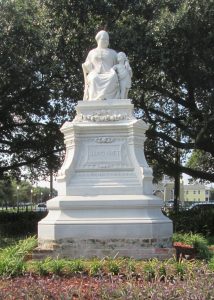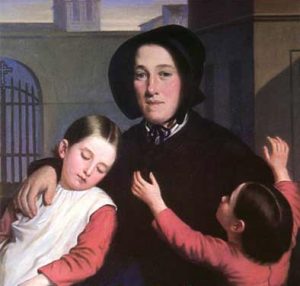
When you visit the beautiful city of New Orleans, be sure to visit the old business part of the city where a statue of a woman overlooks a little square at the corners of Camp and Clio streets. The woman sits in a chair with her arms around a child. The woman is nither young or pretty and she wears a plain dress with a little shawl. She is a bit pudgy and her face is a square-chinned Irish face, but her eyes look at you like your mother’s. It is one of the first statues ever erected in America to honor a woman, for this was a woman unlike any other.
She was born Margaret Gaffney in County Cavan, Ireland. Her family emigrated to Baltimore in 1818, but her parents died in a Yellow Fever epidemic four years later leaving young Margaret an orphan at the age of nine. Left on her own, she never acquired an education and a non-related family gave her a job as household help. In 1835, she married Irish-born Charles Haughery and they moved to New Orleans where she lost both her husband and a newborn baby to a cholera epidemic. Margaret was again alone and penniless.
She found work as a laundress in a hotel and then later in an Orphan Asylum run by the Sisters of Charity. She became very attached to the children there and devoted her spare time to raising funds for them. She bought two cows and a delivery cart and sold milk door to door in the early mornings before work, giving her profits to the orphanage. As profits allowed, she increased the herd and soon she was assigned to manage the orphanage’s herd of 40 cows which provided milk for the children. She sold surplus milk and raised yet more funds. On her way back from her rounds, she begged day-old food from hotels and bakeries and left-overs from the homes of the more affluent. She brought it all back in her cart to the children. She was so successful that the nuns were able to open several other facilities and Margaret was given a position in the administration of the orphanages. The Female Orphan Asylum of the Sisters of Charity, built in 1840, was largely due to her work. She would eventually be responsible for opening four more orphanages in New Orleans.
A yellow fever epidemic in 1853 found her going from house to house, nursing victims, and consoling dying mothers with the promise to look after their little ones. The epidemic left thousands of children homeless, and Margaret channeled all her profits into a new endeavor – the St Vincent de Paul Infant Asylum, which opened in 1862. At one point, she loaned money to a baker, who soon went bankrupt. The only way she could recover her money was to take control of the bakery and operate it. She made the bakery a success and it provided her with a small fortune and jobs for many people. She supplied all the asylums in New Orleans with what was known as ‘Margaret’s Bread’ at such a low price that it was virtually free.

When Union General Benjamin Butler occupied New Orleans during the American Civil War, he declared martial law, erected barriers and set curfews. No one was allowed outside the barriers after curfew. Margaret distributed food and milk to the needy outside those lines, including hungry soldiers and Confederate prisoners and she continued to do so. General Butler ordered her to appear before him and admonished her to stay behind the lines, telling her she would be shot if she crossed them again. Margaret said she would write to President Lincoln and ask if it was his will to starve the poor? General Butler reportedly stormed You are not to go through the picket lines without my permission, is that clear? Quite clear, answered Margaret defiantly and with such a determined look in her eye that Butler, noting her expression, responded, You have my permission.
In time, everyone in the city came to know of Margaret, mother to the motherless and friend to the friendless. She was given many titles, including Bread Woman of New Orleans, Mother of Orphans, Angel of the Delta and most affectionately, Our Margaret. Children all over the city loved her, businessmen were proud of her and many came to her for advice. She would sit at the open door of the orphanage in a calico gown and a little shawl giving a kind word to everybody, rich or poor, who came by. Despite the vast sums of money at her disposal, she spent little on herself and was reputed to have never owned more than two dresses at one time – a plain one for everyday use and a simple silk dress and mantle for Sundays and special occasions. At all times she wore a Quaker bonnet, which became something of a trademark.
Then, at age 69, Margaret contracted an incurable disease. She was cared for by her friends, the Sisters of Charity, as people of all classes and denominations visited her. Margaret Gaffney Haughery died on February 9, 1882. Her body was laid in state at St. Vincent’s Asylum and thousands queued to pay their respects. The city newspapers were edged in black to mark her passing, her funeral procession was the largest ever seen with the mayor of New Orleans leading the procession and the Louisiana governor and former governor as pallbearers.
Almost immediately, a Carrera Marble monument to her was ordered and two years after her death it was unveiled by children from every orphanage in the city. The cost of the memorial was donated in nickels and dimes – “No large sums would be accepted” so that everyone would be able to say they contributed. The statue, sculpted to resemble how she looked sitting in her office door, is engraved with only one word – Margaret!
When her will was read, it surprised many to learn that she had amassed a considerable sum of money through her labors and investments. It was no surprise, however, that she left it all to the various orphanages throughout the city. And her will was signed with a cross, for despite her many accomplishments, Margaret never did learn to read or write!
Mike McCormack, AOH National Historian (originally publish 2020)
THIS IRISH AMERICAN HERITAGE MONTH PROFILE IS PRESENTED BY THE ANCIENT ORDER OF HIBERNIANS (AOH.COM)
#IrishAmericanHeritageMonth